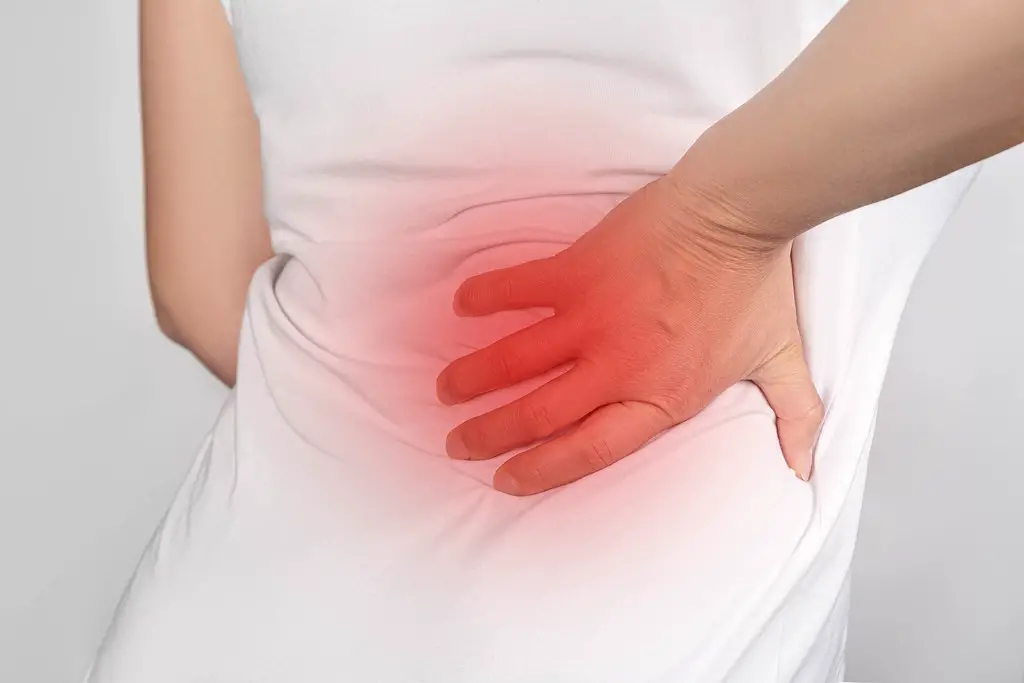In very rare cases, it happens that the spinal stenosis (narrow lumbar canal) is complicated by a neurological syndrome called “ cauda equina syndrome ».
It's about a serious emergency which, in the event of delayed diagnosis and despite optimal management, can lead to irreversible sequelae likely to compromise the functional prognosis of its carrier.
What is the causal link between spinal stenosis and cauda equina? What are the symptoms of this syndrome? What does his treatment consist of? Answers in this article.
A bit of anatomy
The vertebral column, also called the “spine”, is a continuity of 33 vertebrae stacked on top of each other.
The rachis has a canal called " Spinal canal » which contains in its center the spinal cord and nerve roots. These leave the spine through orifices (foramen) to ensure nervous control of the upper and lower limbs.
The spinal cord ends at the level of the Lumbar spine, opposite the 2nd vertebra (L2) to give rise to a set of nerve roots whose shape resembles a horse's tail, hence their name " ponytail ».
Thanks to its 10 pairs of nerve roots, the ponytail ensures the innervation of the muscles of the lower limbs as well as the organs located in the pelvis (bladder, intestines and genitals).
Sometimes the spinal cord becomes compressed due to a narrowing of the lumbar canal. When this compression concerns the ponytail, this will induce the famous ponytail syndrome.
Spinal stenosis: what is it?
La spinal stenosis ou narrow lumbar canal, is a pathological entity characterized by a narrowing of the spinal canal (reduction of its diameter) at the lumbar level. It has the potential consequence of compressing the spinal cord as well as its nerve roots.
In the literature, stenosis most often concerns the cervical and lumbar spines respectively describing the cervical spinal stenosis and lumbar spinal stenosis.
In rare cases, spinal stenosis leads to compression of the roots of the cauda equina causing serious symptoms occurring in an emergency context. This is cauda equina syndrome!
What is cauda equina syndrome?
Cauda equina syndrome is a neurosurgical emergency in which there is compression of the roots of the cauda equina without medullary pain. That is, the spinal cord is intact up to where the ponytail begins (from L2).
Compression of the ponytail is responsible for a peripheral neurogenic syndrome manifested by localized signs in the perineum and both lower limbs.
The clinical picture is characterized by the predominance of genito-sphincter signs which are of early onset.
Link to spinal stenosis
From a pathophysiological point of view, cauda equina syndrome is most often caused by a herniated disc.
Typically, a herniated disc causes compression of the spinal cord. However, it happens that the hernia causes the expulsion of a fragment of the intervertebral disc towards the cauda equina area, thus causing its compression. This is often the case with distal (lumbosacral) disc herniations.
La spinal stenosis is also one of the causes of cauda equina syndrome.
As mentioned previously, the lesional mechanism is typically a narrowing of the spinal canal which, when it occurs at the lumbar level (lumbar spinal stenosis), induces compression of the roots of the cauda equina responsible for the syndrome bearing the same name.
This scenario is an extreme emergency in neurosurgery that requires early treatment. Generally, surgical decompression should be performed within 24 to 48 hours of the onset of symptoms.
Other causes of cauda equina syndrome
A variety of other conditions can also cause cauda equina syndrome, including:
- Spondylodiscitis et osteomyelitis
- Large tumors pressing on cauda equina nerves
- spina bifida: congenital malformation of the spinal cord (in children)
- Damage to the meninges surrounding the spinal cord: infection (arachnoiditis), cyst, epidural abscess, etc.
- Iatrogenic cause: related to a post-operative complication of spine surgery
- Traumatic cause (fall, injury, accident) causing vertebral fractures
What are its symptoms?
The clinical presentation of cauda equina syndrome is essentially made up of:
Pain
It may be low back pain (lower back pain), sciatica (pains of sciatica) or of cruralgia (crural neuralgia) felt along the lower limbs and pelvis.
Sensory-motor deficits
Since the ponytail is responsible for the sensitivity and motor skills of the lower limbs, its compression leads to sensory disorders such as tingling,numbness ou tingling.
As for motor disorders, compression can result in difficulty or inability to walk, as it can lead to total paralysis ou partielle lower limbs.
Genito-sphincter disorders
In addition to neurological disorders, the cauda equina syndrome is characterized by a dysfunction of the urogenital system resulting mainly in:
- Urinary problems such as urinary incontinence to urination
- Anorectal disorders: ranging from Constipation to one faecal incontinence
- Sexual disturbances, including low libido et erectile disorders.
Is that bad ? (What to do ?)
The prognosis depends on the type of attack as well as the precocity of its management.
If it is an isolated spinal stenosis (without complications), generally a conservative treatment or possibly a decompression surgery allows a favorable evolution without sequelae.
However, when the stenosis is complicated by cauda equina syndrome, this is an extreme emergency whose consequences are unfortunately irreversible despite early and rapid intervention.
At this stage, management is essentially based on surgery, the main purpose of which is to minimize irreversible sequelae (motor and sphincter disorders).
The surgical intervention must be done immediately, and the time elapsed between the onset of symptoms and the intervention must not exceed 24 to 48 hours.
Technically, the surgical procedure consists of relieving the high pressure exerted on the roots of the ponytail (decompression surgery). To do this, the surgical team performs a surgical excision of the disc if it is a herniated disc, or to a laminectomies (removal of the spinal blades) in the case of spinal stenosis.
Medical treatment
As part of the management of cauda equina syndrome, medication should be initiated in addition to surgery in order to relieve the patient and improve his prognosis.
The drugs prescribed are:
- Personalized analgesics ou anti-inflammatory to target post-operative pain
- Personalized corticosteroids injectables during hospitalization aimed at reducing inflammation
- Personalized antibiotics when it is an infectious cause, or as a preventive measure post-operatively
- A urinary catheter ou catheter to control urinary incontinence.
Functional rehabilitation
Rehabilitation also has its place in the management of this condition. Its indication is essentially based on the improvement of the patient's functional prognosis. Thus, she will control the sequelae related to the cauda equina syndrome or her surgery.
The physiotherapists (physiotherapists) opt for natural therapeutic methods (massages, exercises, etc.) aimed at relieving pain, controlling balance and strengthening the muscles of the lower limbs.
Conclusion
Cauda equina syndrome is a serious emergency whose prognosis depends on early diagnosis and rapid treatment.
Despite surgery, the sequelae that have already taken hold may persist permanently and affect the patient's quality of life. It is therefore essential to consult a doctor quickly as soon as one of the symptoms mentioned in this article appears.
It must be remembered that the more you act, the better the prognosis and the less severe the sequelae.
My name is Sidali. I am a general practitioner and Web Editor. As a healthcare professional, my mission is to contribute to the relief of my patients' ailments. Being also passionate about writing, I have the pleasure of sharing my solid medical knowledge with the greatest number of readers, by writing popular articles that are very pleasant to read.


